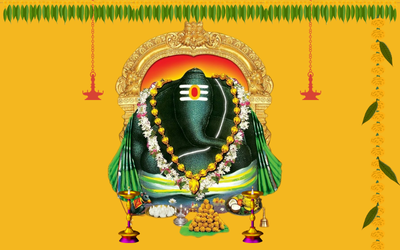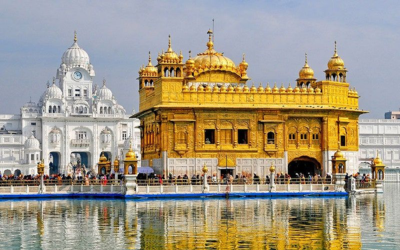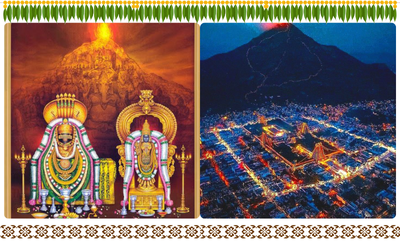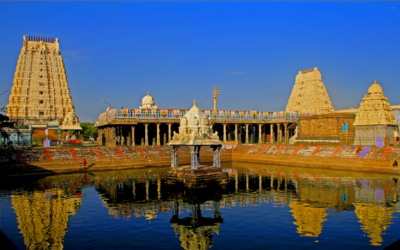Kanipakam
Sri Varasiddhi Vinayaka Swamy Temple
Main Road, Kanipakam Village, Irala Mandal,
Chittoor District, Andhra Pradesh – PIN 517131
Open daily from 4:00 AM to 9:30 PM
Major Ritual Schedule:
Suprabhatham & Bindu Theerthabhishekam: 4:00 AM – 5:00 AM
Nijaroopa Darshanam: 5:00 AM–5:30 AM, 7:00–7:30 AM, 8:30–9:00 AM, 10:30–11:00 AM, 4:30–5:00 PM
Special Abhishekam: 5:30–6:00 AM; additional slots around 9:00–10:00 AM & 11:00 AM–12:00 PM
Sarva Darshanam (General viewing windows): Multiple slots through the day, early morning, late morning, afternoon, and evening till 9:00 PM
Ksheera Abhishekam: 7:30–8:00 AM & 5:45–6:15 PM
Pramanaalu (ritual readings): 5:00–5:30 PM
Maha Harathi: 6:15–6:45 PM
Ekantha Seva (Closing ritual): 9:00–9:30 PM

Kanipakam Sri Varasiddhi Vinayaka Temple is a self‑manifested (Swayambhu) Ganesha shrine, believed to be growing over time—a spiritual marvel as the idol doesn’t fit older armour used decades ago Constructed in the 11th century CE by Chola emperor Kulottunga I and later expanded by Vijayanagara rulers, it is now managed by the Andhra Pradesh Endowments Department Located approx. 11 km from Chittoor and 68 km from Tirupati, the temple draws devotees for its unique miracles and vibrant rituals The 21‑day annual Brahmotsavam starts at Vinayaka Chavithi, featuring processions on decorated vahanas and large pilgrim gatherings
Daily pujas include Ganapathi Homam, Sahasranama Archana, Panchamrutha Abhishekam, Nitya Kalyanotsavam, Unjal Seva and Swing rituals—each aimed at bestowing spiritual and material blessings

Sri Harmandir Sahib (Golden Temple)
Golden Temple Rd, Katra Ahluwalia, Atta Mandi,
Amritsar, Punjab – 143006, India
Open daily from 4:00 AM to 10:00 PM (some sources mention extension up to 11:00 PM)
Golden Temple
Sri Harmandir Sahib, also known as the Golden Temple, is the most sacred shrine in Sikhism, located in Amritsar, Punjab. Built in the 16th century by Guru Arjan Dev, it was later beautified with gold by Maharaja Ranjit Singh. The temple sits in the middle of the Amrit Sarovar (holy pool), and its golden dome and white marble walls blend Hindu, Islamic, and Rajput architectural styles. It has four entrances symbolizing equality and openness to all. The temple is famous for continuous kirtan (devotional singing), the Guru Granth Sahib scripture, and the sacred ritual of bathing in the holy water. A key feature is the world’s largest free community kitchen (langar), which serves meals to over 100,000 visitors daily regardless of caste, religion, or status. The Akal Takht, Central Sikh Museum, and historical trees within the complex also hold great spiritual and historical importance.

Arulmigu Arunachalesvara Temple (Annamalaiyar Temple)
Sannathi Street, Pavazhakundram,
Tiruvannamalai, Tamil Nadu – 606601, India.
Morning Darshan: 5:30 AM – 12:30 PM
Evening Darshan: 3:30 PM – 9:30 PM
(Timings may be extended on weekends and full moon days)
Daily Pooja Schedule
Ushathkalam: 5:30 AM – 7:00 AM
Kalasanthi: 8:30 AM – 9:30 AM
Uchikalam: 11:00 AM – 11:30 AM
Sandhya Pooja: 6:00 PM – 6:30 PM
Irandamkalam: 7:30 PM – 8:00 PM
Ardhajama Pooja: 9:00 PM – 9:30 PM
Arulmigu Arunachalesvara Temple
Arunachalesvara Temple, situated at the base of Arunachala Hill in Tiruvannamalai, is one of the holiest Shiva temples in South India. It represents the element of Agni (fire) among the Pancha Bhoota Sthalams. The temple has a grand architectural presence, covering 25 acres and featuring a 66-meter tall Rajagopuram (main tower), four large gopurams, and intricately carved stone halls. It dates back to the Chola dynasty and was later expanded by Vijayanagara kings. The temple is a hub of spiritual energy and attracts millions of pilgrims, especially during the Karthigai Deepam festival when a huge flame is lit atop the Arunachala hill. Devotees also perform Girivalam, a 14 km circumambulation around the hill on full moon days. The temple is revered in Tamil Saiva literature and is associated with saints like Appar, Sundarar, and Ramana Maharshi, making it a powerful center of devotion and meditation.

Sri Ekambareswarar Temple (Arulmigu Ekambaranathar Temple)
Ekambaranathar Sannidhi Street, Periya,
Kanchipuram, Tamil Nadu – 631502, India
emple Timings (Daily Darshan)
Morning: 6:00 AM – 12:30 PM
Evening: 4:00 PM – 8:30 PM
Daily Pooja Schedule
| Pooja | Time |
|---|---|
| Ushakkala (Sunrise) | ~6:00 AM |
| Kalasandhi | ~7:00 AM |
| Uchikala (Noon) | ~12:00 PM |
| Pradosham (Special) | ~5:00 PM |
| Sayaraksha | ~6:00 PM |
| Ardhajama (Night) | ~8:00 PM |
Kanchi
Ekambareswarar Temple, located in Kanchipuram—historically known as the “City of Thousand Temples”—is one of the Pancha Bhoota Sthalams, representing the element of Earth (Prithvi). Devoted to Lord Shiva as Ekambareswarar (or Ekambaranathar), it houses the Prithvi Lingam, and his consort Parvati is worshipped as Elavarkuzhali. The temple complex spans approximately 25 acres and includes a soaring southern Raja Gopuram of about 58 m—among the tallest in South India.
Dating back to the Pallava period (~600 CE) and later expanded by Chola and Vijayanagara dynasties, the temple features the famed Aayiram Kaal Mandapam (Hall of Thousand Pillars), and walls carved with 1,008 mini Shiva lingams. The sacred kampai tirtha tank is said to connect to an underground stream. The legendary mango tree, believed to be over 3,500 years old, stood within the temple; devotees believe Parvati performed penance under it and fashioned a Shiva lingam from sand.
A major festival, Panguni Uthiram, is celebrated in March–April for 13 days with elaborate processions and ceremonial weddings of Shiva and Parvati. Pilgrims flock to the temple during pradosha, full moon, and new moon days.